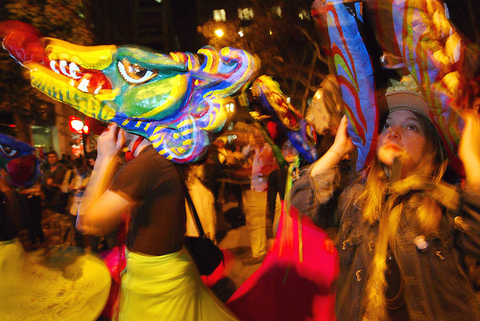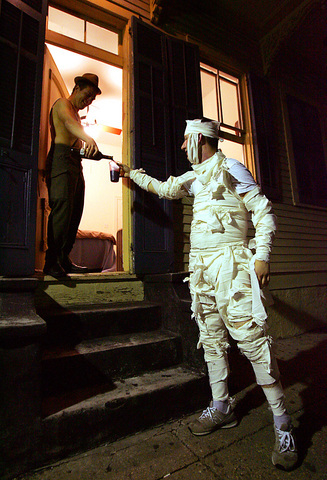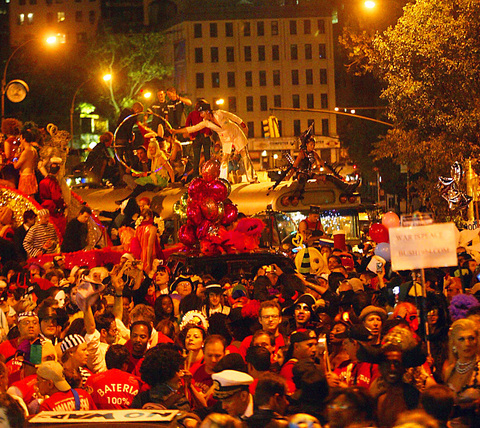For more than two months, Dave Weiss has been painstakingly planning the details of his Halloween celebration. Last year, he and his wife, Katie Harrigan, carved pumpkins and
labored for several hours in their Hoboken, New Jersey, apartment to make a chicken pie with sherry shallot jus gravy. They bought Smuttynose Pumpkin Ale, baked ghost-shape cookies and savored their favorite sweet, the dark chocolate pumpkin from La Maison du Chocolat. But the pumpkin has competition this year.
Weiss, a 32-year-old photo transmissions manager, is tempted by the spiced pumpkin-shaped cake at Dean and Deluca.

"I buy the chocolates every year," he said, "but this cake just looks so good."
The couple are as hooked on Halloween as any
8-year-olds.

PHOTO: NY TIMES NEWS SERVICEN
"As I'm getting older, I find Halloween becoming my favorite holiday," Weiss said. "It's the perfect time for a foodie like me."
According to retailers, Halloween now has a distinctly adult mood. Anna Baxter Kirk, a spokeswoman for the online costume store BuyCostumes.com, said the sales for adult Halloween costumes are slated to overtake those of children's for the first time this year. But for adults, Halloween is also about fancy candy, sophisticated food and drink, and perhaps above all, having an excuse to indulge.
Cress Templeton, 46, a lawyer from Bel Air, California, said many of his neighbors hold open houses on Halloween.

PHOTO: NY TIMES NEWS SERVICE
"People buy cases of good wine and get platters of appetizers. Last year, my wife and I bought sushi rolls and salmon tarts," Templeton said. "The adults go from house to house drinking and eating away."
Chandrika Tandon, a 50-year-old businesswoman who lives on the Upper East Side of Manhattan, said she looks forward to her building's Halloween open house.
Last year, she said, "there was a lot of food from Eli's Vinegar Factory like shrimp cocktail and cheese pies."
Stacy Hoffman, a 35-year-old giftware company owner in Manhattan, said Halloween was increasingly becoming an occasion like New Year's Eve, when adults feel they can drink a little more than usual. "The funky cocktails only add to the festive spirit," she said.
"Baby boomers are driving the adultification of
Halloween," said Susan Fussel, spokeswoman for the National Confectioners Association. "Trick-or-treating didn't really take off and become big until the baby boomer generation," she said.
Candy sales account for US$2 billion of the US$3 billion Halloween industry, Fussel said. There are no specific figures on upscale candy, which she said makes up more and more of overall sales.
Retailers have been quick to try to satisfy customers' craving. La Maison du Chocolat, based in Paris, started catering to the Halloween market five years ago at the request of US customers, said Nora Hovanesian-Mann, who manages the Madison Avenue branch.
"Since Halloween is not celebrated in France, we created products for our American customers and were stunned by how well they were received," she said. A top-selling item is the US$50 chocolate pumpkin filled with caramelized roasted almonds, Weiss' usual splurge.
At Neiman Marcus, Halloween is the second biggest holiday for sales, trailing only Christmas, said Diane Somers, a merchandise manager. Its Halloween items include a US$70 box of 18 Eleni's cookies shaped like bats and ghosts.
Some adults prefer candy that reminds them of childhood. Jerry Cohen, the owner of Economy Candy on Manhattan's Lower East Side, said that in the last five years he has had to order more of the candy he ate while growing up in the 1950s and 1960s.
"The Wack-o-Wax Lips, the Mary Janes," he said. "These adults want all the candy from when they were young."
Nostalgic candy holds less interest for Dave Weiss. He is deliberating over the chocolate pumpkin and the spiced cake.
"We've already bought our pumpkin beer, but I'm not sure what the rest of the menu is yet," he says. "I do know that it will be a memorable meal."

In the March 9 edition of the Taipei Times a piece by Ninon Godefroy ran with the headine “The quiet, gentle rhythm of Taiwan.” It started with the line “Taiwan is a small, humble place. There is no Eiffel Tower, no pyramids — no singular attraction that draws the world’s attention.” I laughed out loud at that. This was out of no disrespect for the author or the piece, which made some interesting analogies and good points about how both Din Tai Fung’s and Taiwan Semiconductor Manufacturing Co’s (TSMC, 台積電) meticulous attention to detail and quality are not quite up to

April 21 to April 27 Hsieh Er’s (謝娥) political fortunes were rising fast after she got out of jail and joined the Chinese Nationalist Party (KMT) in December 1945. Not only did she hold key positions in various committees, she was elected the only woman on the Taipei City Council and headed to Nanjing in 1946 as the sole Taiwanese female representative to the National Constituent Assembly. With the support of first lady Soong May-ling (宋美齡), she started the Taipei Women’s Association and Taiwan Provincial Women’s Association, where she

Chinese Nationalist Party (KMT) Chairman Eric Chu (朱立倫) hatched a bold plan to charge forward and seize the initiative when he held a protest in front of the Taipei City Prosecutors’ Office. Though risky, because illegal, its success would help tackle at least six problems facing both himself and the KMT. What he did not see coming was Taipei Mayor Chiang Wan-an (將萬安) tripping him up out of the gate. In spite of Chu being the most consequential and successful KMT chairman since the early 2010s — arguably saving the party from financial ruin and restoring its electoral viability —

It is one of the more remarkable facts of Taiwan history that it was never occupied or claimed by any of the numerous kingdoms of southern China — Han or otherwise — that lay just across the water from it. None of their brilliant ministers ever discovered that Taiwan was a “core interest” of the state whose annexation was “inevitable.” As Paul Kua notes in an excellent monograph laying out how the Portuguese gave Taiwan the name “Formosa,” the first Europeans to express an interest in occupying Taiwan were the Spanish. Tonio Andrade in his seminal work, How Taiwan Became Chinese,